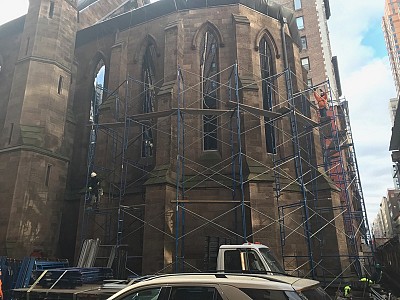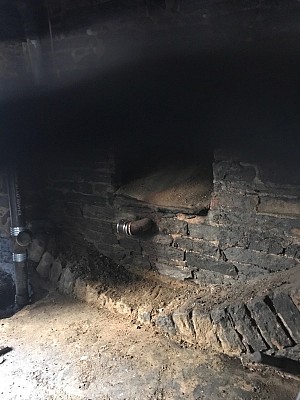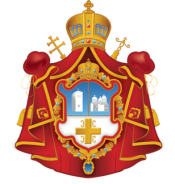Phase II continues: Rebuilding New York’s St. Sava Cathedral
By the beginning of the Old Calendar New Year 2018, the erection of the interior scaffolding, required for the removal of the severely damaged Caen Stone, was fully put into place. Caen is the limestone, which comprised the interior finishing layer of stone of New York’s St. Sava Cathedral. Unfortunately, given its soft composition and the intensity of the fire on Pascha 2016, it could not be salvaged. The Caen stone removal is now completed on the East elevation of the interior nave wall, as well as the removal of a damaged archway near the sanctuary.
Again, according to an article, “Our neighbor, the Cathedral of St. Sava”, the Cathedral’s architect, Richard Upjohn, “...chose pure, honest materials that showcased the artisans’ craft—hand-carved trusses and hand-dressed Caen (pronounced “kahn”) limestone, which covered the entire interior and was the cause of cost overruns. It was worth it; the interior has been widely considered to be Upjohn’s masterpiece”(http://easterndiocese.org/news_171010_1.html). It is truly difficult to observe the removal of an irreplaceable piece of New York architectural history, especially one that is so imbued with pray and sanctity.
This necessitated removal, which is being carried out by G.P.J. O'Donoghue Contracting Corporation, is a very complex physical and even emotional process. The Caen Stone is rather easily removed, albeit, a painstaking and careful endeavor entirely executed by hand, with only the occasional light use of a crowbar, as there was no mortar used in the erection of the interior church walls. Given that the church was built by European builders, strictly relying upon tried and true Old World techniques, every step of the restoration process reveals something of the genius that went into the building of this masterpiece of an edifice. The Cathedral walls are three stone layers deep: hand chiseled Brownstone on the outside, roughly hewn black Granite in between, and the interior, as noted, finished in hand dressed Caen. As Granite, by its natural composition, is fireproof, the central layer of hard stone essentially secured and secures the Cathedral walls.
Another fascinating discovery is the correlation between the walls which are standing sturdily and the use of ‘reverse’ Gothic arches in the crypt. As the lower level of the nave walls were replete with niches that consisted of a blind arcade of Gothic arches, each upward arch, with its characteristic Gothic point, found its counterbalance in a reverse counter point in the crypt. Ever upstanding arch continued into the crypt of the Cathedral with a reverse arch that entered into the ground and literally transferred the weight of the walls into the ground. In the opinion of some architects, this may be one of the few, if not the only standing example of such medieval architectural techniques executed in the United States.
Presently, scaffolding is also being erected around the outside of the entire church to enable forthcoming work on the roof, repairing damaged Brownstone architectural details and securing the enclosure of the windows and doors. With God’s help, we move forward with the restoration of hope, the preservation of history and securing the future of St. Sava Cathedral and its community in New York City!
In the wake of the fire, and in anticipation of the Feast of St. Sava, let us all pray fervently and sing from all our hearts: ‘Saint Sava, help us. Hear the voice of our generation, your Serbian people’!
Свети Саво, ти помози. Почуј глас свог рода, српскога народа!
Bishop +Irinej
Повратити наду, сачувати историју и обезбедити будућност: наставља се са другом фазом обнове Саборног храма Светог Саве у Њујорку
Почетком старокалендарске Нове 2018. године, постављене су скеле са унутрашње стране зидова храма како би се отпочело са отклањањем веома оштећеног украсног камена. Овај камен је врста кречњака, који је сачињавао украсни унутрашњи слој зида њујоршког храма Светог Саве. Нажалост, због своје мекоће и интензитета пожара на Васкрс 2016, није се могао сачувати. Отклањање овог камена је у потпуности завршено на источној страни унутрашњег зида цркве као и оштећеног горњег свода у близини олтара.
По чланку, ”Наш сусед Свети Сава”, ахритекта Саборног храма Ричард Апџон, “... изабрао је чист, аутентичан материјал који представља уметнички рад – руком отесаних греда и руком клесаног кречњака, којим је прекривена цела површина унутрашњих зидова, допринели су високој цени овог пројекта. Овај трошак је био вредан јер се овај детаљ сматрао Апџоновим ремек делом.” Заиста је тешко гледати уклањање оваквог незаменљивог дела архитектонске историје Њујорка, а нарочито имајући у виду да је он прожет молитвом и светoшћу.
Ово неопходно отклањање камена, које изводи предузеће ГПЈ О’Донохју, је веома сложен физички и емотивни процес. Кречњак се прилично лако скида али се радови врше са великим напором ручно и само понекад челичном полугом, пошто се при подизању унутрашњих зидова није користио малтер. Будући да су цркву градили европски градитељи, строго се придржавајући познатих и опробаних техника Старог Света, сваки корак процеса обнове открива нешто изузетно што говори о градњи овог грађевинског ремек дела. Зидови храма се састоје од три слоја: ручно исклесаног смеђег камена на спољашњој страни, грубог црног гранита у средини, и у унутрашњег ручно исклесаног кречњака. Како је гранит по својој природној структури отпоран на ватру, средњи слој, који се састоји од солидног камена, стоји чврсто и обезбеђује зидове храма.
Друго изузетно откриће је веза између чврсто стојећих зидова и њиховог усклађеног односа са готским сводовим у крипти. У доњем делу зидова лађе цркве налазили су се готски сводови тако да је сваки свод са својим готским врхом имао своју противтежу у обрнутој контра тачки у крипти. Усправни сводови су настављени у крипти са окренутим луком који улази у земљу и дословно преноси тежину зидова у темеље. По мишљењу неких архитекти ово је можда један од свега неколико примера, ако не и једини очувани пример такве средњевековне архитектонске технике изведене у САД.
Такође, скеле се подижу и са спољашње стране зидова храма како би се омогућио будући рад на крову, поправљање оштећених детаља смеђег зида и уграђивање прозора и врата.
С Божјом помоћи крећемо напред са обновом наде, очувањем историје и обезбеђењем будућности храма Светог Саве и његове заједнице у граду Њујорку!
С празничним молитвама Светом Сави молимо се свесрдно и певамо из срца: Свети Саво ти помози.
Почуј глас свог рода, српскога народа!
Епископ +Иринеј



